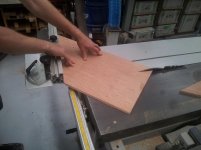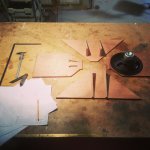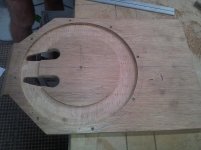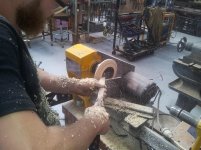Osse:
4 questions, I like to keep designs as simple and homogeneous as possible:
1. Would it be possible to swap all the 18mm ply parts for 12mm?
Yes, it was not intended. Fixed.
2. Would it be possible to use 12mm ply instead of 20x20 cleats to secure back panel?
I dont think changing this would change the volume significantly so I dont see why not. We were thinking 20 (ish) just for strength, and some room for the TNuts.
3. Skip the 4mm dados?
yes done.
4. I see you excluded the "cone plugs" seen in arts pictures, could you exclude them in the cabinet aswell? (Might be a question Art is more qualified to answer)
Just didn't get to it yet. Will put them in.
4 questions, I like to keep designs as simple and homogeneous as possible:
1. Would it be possible to swap all the 18mm ply parts for 12mm?
Yes, it was not intended. Fixed.
2. Would it be possible to use 12mm ply instead of 20x20 cleats to secure back panel?
I dont think changing this would change the volume significantly so I dont see why not. We were thinking 20 (ish) just for strength, and some room for the TNuts.
3. Skip the 4mm dados?
yes done.
4. I see you excluded the "cone plugs" seen in arts pictures, could you exclude them in the cabinet aswell? (Might be a question Art is more qualified to answer)
Just didn't get to it yet. Will put them in.
We have started cutting!
I know the plans are not complete yet as up on here, but it is enough for us to do some prototyping.
We do intend on making the plans awesome, rounding to half a mm and half a degree, and annotating the important angles and measurements to help you get the cuts done right the first time.
We will put the 3D model up when it is closer to the mark, though if anyone wants a peek at the 3D model PM me and I will send them.
I know the plans are not complete yet as up on here, but it is enough for us to do some prototyping.
We do intend on making the plans awesome, rounding to half a mm and half a degree, and annotating the important angles and measurements to help you get the cuts done right the first time.
We will put the 3D model up when it is closer to the mark, though if anyone wants a peek at the 3D model PM me and I will send them.
Attachments
Some more progress. Working on the plugs. Rory created one in about 10 minutes to spec on the laythe.
Correcting the model as we go, and marking out the important measurements, and important notes.
Correcting the model as we go, and marking out the important measurements, and important notes.
Attachments
The Eminence N314T-8 has more clean upper output potential, as much as 6 dB more than the Celestion CDX14-3050 at similar distortion. However, the N314T-8 has 4 dB less output at 950 Hz, the HF electrical crossover point.Art did some tests on the Eminence N314T driver which perhaps he might wish to share his results on.
At 24 dB per octave, the difference between the two drivers at the crossover point is not much, and the 10" drivers have enough upper output potential to "fill the gap".
Considering the price difference, and the fact that the two Celestion CDX14-3050 I received were inconsistent in frequency response, I'd be inclined to use the Eminence N314T-8, especially in a hot dry climate where high frequency air absorption requires far more HF output to compensate.
Art
Rory has two lathes!
I only have one.
All hail Rory!
Nice work. Nasty stuff to turn that luan type plywood.
I only have one.
All hail Rory!
Nice work. Nasty stuff to turn that luan type plywood.
We wont use that ply for the final plugs. Though soft wood works for the lathe nicely. Just had some lying around for a late night cut to keep things moving.
We managed to get them bang on 155 * 78 * 18. (noted in the other syntripp thread)
We managed to get them bang on 155 * 78 * 18. (noted in the other syntripp thread)
Last edited:
ART: Would it be wise to move the ports closer to the mouth if we were to raise the crossover if using the N314T-8?The Eminence N314T-8 has more clean upper output potential, as much as 6 dB more than the Celestion CDX14-3050 at similar distortion. However, the N314T-8 has 4 dB less output at 950 Hz, the HF electrical crossover point.
At 24 dB per octave, the difference between the two drivers at the crossover point is not much, and the 10" drivers have enough upper output potential to "fill the gap".
Considering the price difference, and the fact that the two Celestion CDX14-3050 I received were inconsistent in frequency response, I'd be inclined to use the Eminence N314T-8, especially in a hot dry climate where high frequency air absorption requires far more HF output to compensate.
Art
Last edited:
Nice work Finbot. Nice shop you have there too.
Great to see wood getting cut. Rooting you guys on to first sound.
Great to see wood getting cut. Rooting you guys on to first sound.
AMPLIFICATION:
I know this is a bit of a noob question, but I realized I have not yet acquired this foundation knowledge. I am still uncertain about how to select the amp for power ratings.
Can anyone point me to information about how to select an appropriate amplifier?
I would like to put two cabinets in Parallel, so I need enough power for the mids to be driven at 2 ohms. (or is this just a bad idea?)
These questions might be better placed in an amplifier thread, but it also might be great to use this as an example against this particular set of drivers. The questions I am looking to find the answer to are:
Do I select an amp for the 150 watts nominal or the 300 program for the mids?
To set the gainpath correctly, should I use a sin wave set at zero db into the amp, and then adjust the volume to get the calculated voltage that matches imedence v watts (nominal)?
With an amp, do we still need double the headroom with class D amps?
Should I turn the gain right up and reduce the input on the amps to get me to the nominal output voltage?
Id rather look up the information and learn than have someone give me the answers, but examples are useful for learning.
I know this is a bit of a noob question, but I realized I have not yet acquired this foundation knowledge. I am still uncertain about how to select the amp for power ratings.
Can anyone point me to information about how to select an appropriate amplifier?
I would like to put two cabinets in Parallel, so I need enough power for the mids to be driven at 2 ohms. (or is this just a bad idea?)
These questions might be better placed in an amplifier thread, but it also might be great to use this as an example against this particular set of drivers. The questions I am looking to find the answer to are:
Do I select an amp for the 150 watts nominal or the 300 program for the mids?
To set the gainpath correctly, should I use a sin wave set at zero db into the amp, and then adjust the volume to get the calculated voltage that matches imedence v watts (nominal)?
With an amp, do we still need double the headroom with class D amps?
Should I turn the gain right up and reduce the input on the amps to get me to the nominal output voltage?
Id rather look up the information and learn than have someone give me the answers, but examples are useful for learning.
No, you would want to leave them as close to the throat as possible, where they are.ART: Would it be wise to move the ports closer to the mouth if we were to raise the crossover if using the N314T-8?
No, you would want to leave them as close to the throat as possible, where they are.
Apologies!!!
I meant throat...would we need to get closer to the throat?
What is the current max crossover frequency that the current ports dictate?
Paralell would work fine as long as you are comfortable with mono signal to cabinets, which I would advice against. Also would advice against 2 ohm. Why do you want the setup like this?
I would recommend getting a class AB or TD 4 channel amp with minimum 600 maximum 1000 rms watt at 4 ohm, and drive the midrange drivers each cabs separately paralleled using active crossover on one channel each and the other two for compression drivers.
Set gain at full on amps and adjust gain on your loudspeaker management system, as long as the amp doesn't hiss too much at max level.
Don't know what would be a good contender down in au, in Europe if you are on a budget I would suggest t.amp TSA 4-700. Lab gruppen if no budget constraints.
I would recommend getting a class AB or TD 4 channel amp with minimum 600 maximum 1000 rms watt at 4 ohm, and drive the midrange drivers each cabs separately paralleled using active crossover on one channel each and the other two for compression drivers.
Set gain at full on amps and adjust gain on your loudspeaker management system, as long as the amp doesn't hiss too much at max level.
Don't know what would be a good contender down in au, in Europe if you are on a budget I would suggest t.amp TSA 4-700. Lab gruppen if no budget constraints.
Last edited:
Fin,Apologies!!!
I meant throat...would we need to get closer to the throat?
What is the current max crossover frequency that the current ports dictate?
As previously stated, the 10" bandpass ports are as close to the throat as possible, the 10" drivers are almost touching the HF driver mounting plate.
Check out the charts in post #1 and #9 (and probably several others) to see raw and crossed over responses.
Since you have access to (2!) real lathes, you could make filler plates that would fill even more area of the cone volume, which would raise the upper band pass of the 10" a bit higher than the original build.
Art
1) The minimum impedance drops below 4 ohms per cabinet, so a pair even on a "2 ohm capable" amp may result in current limiting, or worse.AMPLIFICATION:
1)I would like to put two cabinets in Parallel, so I need enough power for the mids to be driven at 2 ohms. (or is this just a bad idea?)
2)Do I select an amp for the 150 watts nominal or the 300 program for the mids?
3)To set the gainpath correctly, should I use a sin wave set at zero db into the amp, and then adjust the volume to get the calculated voltage that matches imedence v watts (nominal)?
4)With an amp, do we still need double the headroom with class D amps?
5)Should I turn the gain right up and reduce the input on the amps to get me to the nominal output voltage?
6)Id rather look up the information and learn than have someone give me the answers, but examples are useful for learning.
2) Or 600+ ?
3) For the average power limiter setting (time constant of around 250ms), sine waves are appropriate. The AES nominal power handling for a pair of B&C 10CL51 is 300 watts. The AES signal is a 6 dB dynamic range pink noise signal, a sine wave has only 3 dB dynamic range, so average level using a sine wave should be st to 150 watts. Peak rating (very short time constant) can be set for 600 watts, more if you are running wide dynamic range music.
4) Depends on the amplifier.
5) Having the gain wide open is safest (no one can accidentally turn up the level higher) but will reduce the signal to noise ratio.
6) I am using a pair of four channel Behringer NU4-6000, two channels bridged mono for the subwoofers, one channel for mid, one for high. In a pinch, if one amp were to fail completely, the system could still be operated in mono from one amp (subs no longer bridged, one per amp channel).
Art
First testing last night!
Bare with me as this is only by fourth speaker build and I am fairly green, but have a reasonable knowledge of sound.
I have a formal education in electronics, physics, and a history of making a living off music.
Here we go:
I took some time to set it as flat as possible.
-MiniDSP umik-1
-REW
-Drive rack PA+
There first results were reasonable when smoothed to 1/6 I think the biggest swing was about 5db. Nice.
I found my eq choices were almost on the mark of Arts on this thread.
Measurements of the mids resembled the initial hornresp predictions.
FIRST IMPRESSIONS:
Well balanced overall for new drivers.
The mid range is very loud when given a tiny bit of power with very little visible movement. 3mm p-p perhaps.
I had to yell to communicate 6 meters away. Still a truckload of headroom in those mids.
NOT SO GOOD:
It's feeling noticeably SHOUTY. I feel as though the mids are a bit harsh on the ears. I feel as though there is some mids being reverberating inside the horn or cabinet. While its flat, perhaps some mids are persisting?
Maybe i need to eq, maybe dampen, maybe its the new driers needing some time.
Anyone have any thoughts or advice on horns sounding shouty? (Is thst making sense?)
I am post the measurements before and after eq and with and without smoothing if anyone would like to see...
Bare with me as this is only by fourth speaker build and I am fairly green, but have a reasonable knowledge of sound.
I have a formal education in electronics, physics, and a history of making a living off music.
Here we go:
I took some time to set it as flat as possible.
-MiniDSP umik-1
-REW
-Drive rack PA+
There first results were reasonable when smoothed to 1/6 I think the biggest swing was about 5db. Nice.
I found my eq choices were almost on the mark of Arts on this thread.
Measurements of the mids resembled the initial hornresp predictions.
FIRST IMPRESSIONS:
Well balanced overall for new drivers.
The mid range is very loud when given a tiny bit of power with very little visible movement. 3mm p-p perhaps.
I had to yell to communicate 6 meters away. Still a truckload of headroom in those mids.
NOT SO GOOD:
It's feeling noticeably SHOUTY. I feel as though the mids are a bit harsh on the ears. I feel as though there is some mids being reverberating inside the horn or cabinet. While its flat, perhaps some mids are persisting?
Maybe i need to eq, maybe dampen, maybe its the new driers needing some time.
Anyone have any thoughts or advice on horns sounding shouty? (Is thst making sense?)
I am post the measurements before and after eq and with and without smoothing if anyone would like to see...
Last edited:
Did you mean you already have some measurements to share or are we doing them tonight?
Well done by the way mate.
Well done by the way mate.
Fin,
The cabinet sides, back and bottom should have damping material. I used 3" fiberglass (stapled on with string between staples), carpet underlayment felt works well too.
The Driverack PA (which was used for the settings shown in the early part of the post) has all outputs reversed polarity from input, no big deal unless combining PAs with a system with "normal" polarity.
I have seen tests of the Driverack PA+ that show the midrange is reversed polarity from low and high, which will create a "hole" in the crossover regions for speakers not requiring a reversal.
Pictures of the raw and equalized frequency response and phase of the mids and highs and processed response would be interesting.
Art
The cabinet sides, back and bottom should have damping material. I used 3" fiberglass (stapled on with string between staples), carpet underlayment felt works well too.
The Driverack PA (which was used for the settings shown in the early part of the post) has all outputs reversed polarity from input, no big deal unless combining PAs with a system with "normal" polarity.
I have seen tests of the Driverack PA+ that show the midrange is reversed polarity from low and high, which will create a "hole" in the crossover regions for speakers not requiring a reversal.
Pictures of the raw and equalized frequency response and phase of the mids and highs and processed response would be interesting.
Art
- Home
- Loudspeakers
- Multi-Way
- SynTripP: 2-way 2-part Virtual Single Point Source Horn



